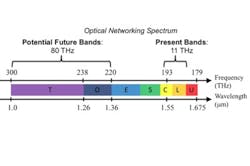(Figure: University of Bristol) Researchers from Keio University (Yokohama, Japan), Pioneer Micro Technology (Kofu, Japan), Koshin Kogaku (Hadano, Japan), Optoquest (Ageo, Japan), and the University of Bristol (Bristol, England) are developing an ultrabroadband all-optical router for data centers that takes advantage of a newly defined frequency band called the T-band, as well as the O-band, which together span wavelengths from 1.0 µm (300 THz) to 1.36 µm (220 THz) -- an 80 THz span -- and are able to support 1600 channels at 50 GHz spacing.1 Conventional work has been focused and limited on utilizing 11 THz of bandwidth (C and L Band) centered at 1.55 μm (193 THz). Optical networks based on these frequency bands have been able to support up to 230 channels at 50 GHz spacing. Due to constant growth of networked infrastructures (now including "internet of everything" as well as data centers), fiber capacity is reaching its limits. "The technology and system proposed and prototyped will unlock the new frequency band and networks to support future exascale data centers, 'zero-latency' tactile optical internet, internet of everything, smart cities, fog computing, and big-data infrastructure, among others," says Georgios Zervas of the University of Bristol.Quantum-dot light sources The technology fabricated and tested is based on cascaded arrayed waveguide gratings (AWGs) and is designed to potentially construct an all-optical 1600 x 1600 wavelength router. Custom quantum-dot chips are used for light sources; these were originally developed at the National Institute of Information and Communications Technology (NICT; Tokyo, Japan). Source: http://www.bristol.ac.uk/news/2016/february/communication-systems.html REFERENCE: 1. Nazirul A. Idris et al., Optics Express (2016); doi: 10.1364/OE.24.000672
Sponsored Recommendations
Sponsored Recommendations
Working with Optical Density
Feb. 26, 2025
Finding the Right Dichroic Beamsplitter
Feb. 26, 2025
Measurement of Optical Filter Spectra
Feb. 26, 2025
Voice your opinion!
Voice your opinion!
